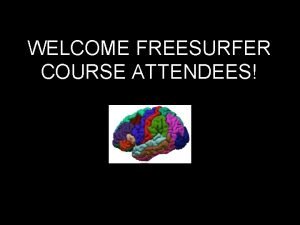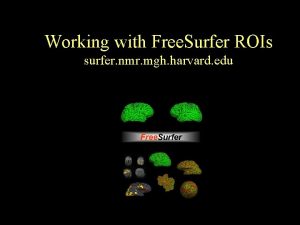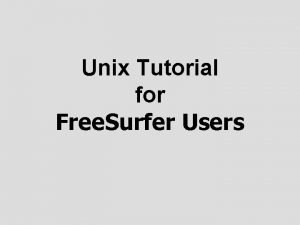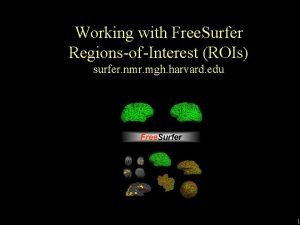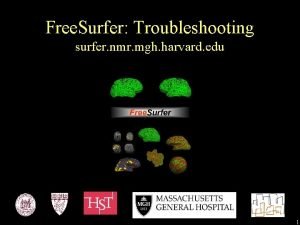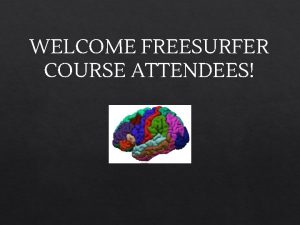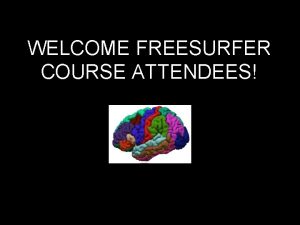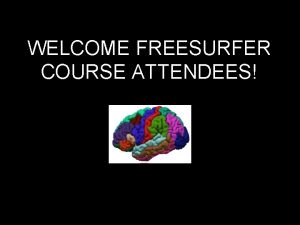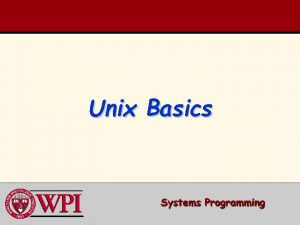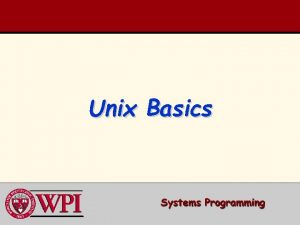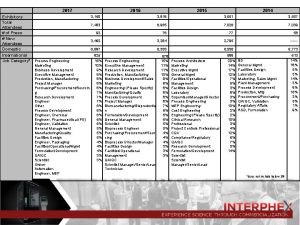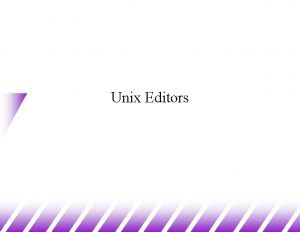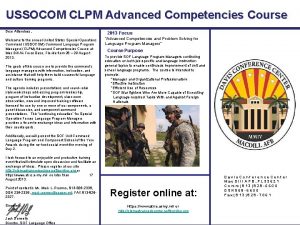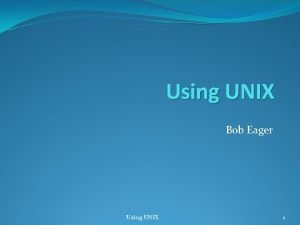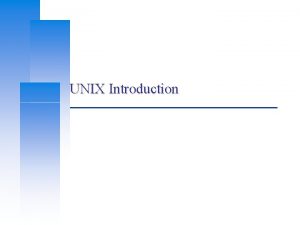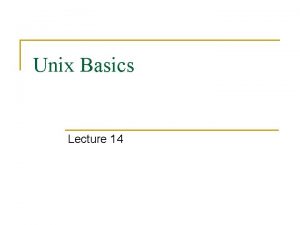WELCOME FREESURFER COURSE ATTENDEES Introduction to Unix for



































- Slides: 35

WELCOME FREESURFER COURSE ATTENDEES!

Introduction to Unix for Free. Surfer Users • • • Navigating directories Listing directory contents Creating new directories and text files Copying and moving files Setting up environment variables specific to Free. Surfer

What is Unix/Linux? • An operating system (like Windows and OS X) • Linux is the free, modifiable, and redistributable version of Unix • Why use it? ◈ Power to write many scripts with many commands to work with lots of data ◈ To use computer resources on the network efficiently, such as clusters

Getting Started Communicate with operating system through a “shell” or terminal window. For course-provided Linux computers: Double click Terminal icon on Desktop For Macs: Applications > Utilities > XQuartz (double click) Applications > Utilities > Terminal

Linux Desktop

Directories ◈ Unix uses a hierarchical file system (think folders in Windows)

Directories Home is like “My Computer” Ex. “My Documents ” Ex. “My Photos” picture. jpg

Anatomy of a Command command -option 1 command –option 2 --help file

Try it yourself Type the following command hit enter! pwd You can also run this command for more information on “pwd” pwd --help

Determining Your Location • The ”pwd” command stands for present working directory • The output is your current location as a path • Your output should be either: /home/nmrclass /Users/Your. Name

Navigating Directories Now you can practice changing directories, type: ls Which stands for “list” To move into another folder, use the command: cd <directory name> Which stands for “change directory”

Navigating Directories To list the files within your current working directory, type: cd /home/nmrclass Then type this: ls If your present working directory is this Typing ls will print these names to your terminal

Directory Contents The “ls” command has several flag options to display different information about the contents of the directory. ls ls -a ls -lrt Lists names of files and directories

Directory Contents The “ls” command has several flag options to display different information about the contents of the directory. ls ls -a ls -lrt Lists names of files and directories Also lists any hidden files (ex. . alias, . bashrc, . cshrc)

Directory Contents The “ls” command has several flag options to display different information about the contents of the directory. ls Lists names of files and directories ls -a Also lists any hidden files (ex. . alias, . bashrc, . cshrc) ls -l Lists file/directory details ls -lrt d{rwx}{---} # owner group User Group Others

Directory Contents The “ls” command has several flag options to display different information about the contents of the directory. ls Lists names of files and directories ls -a Also lists any hidden files (ex. . alias, . bashrc, . cshrc) ls -l Lists file/directory details ls -lrt Lists the most recent files last

Save Some Time Filename Completion: Type: ls Des And then hit tab. You should see the rest of the word “Desktop” appear, now hit enter. History: You can use the �key to scroll through previously submitted commands

Changing Directories You can create a new directory using the command: mkdir <new directory name> Try this by making a new directory named “Practice” mkdir Practice Now when you run ls you should see Practice listed. You can now change directories to get to practice by running: cd Practice Try running pwd, this should return /home/nmrclass/Practice Now run ls, nothing should output since the directory “Practice” is empty

Changing Directories

Try it Yourself! mkdir stuff ls Makes the folder “stuff” inside Practice You should now see the folder “stuff”

Using Dots You can also use dots to quickly list files and move to different directories. ls. . Lists the files/directories one level up ls. . /. . Lists the files/directories two levels up Two levels up One level up You are here You can also use this trick when changing directories using the command cd

Using an Editor To open a text editor, start with the following command: gedit mynotes. txt If using Linux emacs mynotes. txt If using Mac Now, you may type whatever you’d like, for example type “I could write a script” File -> Save Close gedit or ctrl + q If using Linux Ctrl + x and Ctrl + s (to save) Ctrl + z (to exit) If using Mac When you type ls you should now see your file.

Using an Editor

Viewing file contents You can quickly view the contents of a file using one of the following commands: less mynotes. txt more mynotes. txt To exit viewing the file using less, type: q

Copying files You can copy a file to a new location using the command: cp cp --help Now, try it with the ”mynotes. txt” file you created! cp mynotes. txt stuff File to move New location

Copying files You can check that the file moved by running: cd stuff ls more mynotes. txt

Copying / Moving files To move a file to a new location, use the command: mv mv --help Try using this command by first creating a copy of mynotes. txt cp mynotes. txt myothernotes. txt mv notes. txt. . Rename the file Move the file one level up

Removing Files To delete a file, use the command: rm Use the command with caution! Now, let’s remove the mynotes. txt file in the Stuff directory: pwd You should be in the Stuff directory ls You should see the mynotes. txt file rm mynotes. txt ls Remove the mynotes. txt file You should no longer see the mynotes. txt file

Removing Files

Things to know • Case sensitive – Ls vs ls • Does not use spaces in file names (e. g. filename. txt vs. file name. txt) • Ctrl+c kills a process & brings back command prompt • Highlight & middle click to copy & paste • Use ‘&’ to open a program in the background • When typing commands on a Mac, Ctrl+a goes to the start of the command line, Ctrl+e goes to end, and Ctrl + u clears the command line.

Using Free. Surfer When using Free. Surfer, certain variable must be set in order to use it. FREESURFER_HOME Tells the operating system where Free. Surfer is located SUBJECTS_DIR Tells Free. Surfer where the data is located

Required Variables To set these variables, the following commands are required: export FREESUFER_HOME=/home/apps/freesurfer This command tells the operating system where Free. Surfer is located source $FREESURFER_HOME/Set. Up. Free. Surfer. csh Sourcing this script gets your computer ready to use Free. Surfer export SUBJECTS_DIR=/path/to/data This command tells Free. Surfer where your data is located

Required Variables You may also see these commands written with setenv instead of export setenv FREESUFER_HOME=/home/apps/freesurfer source $FREESURFER_HOME/Set. Up. Free. Surfer. csh setenv SUBJECTS_DIR=/path/to/data

Required Variables You can go to the location of your data with the command: cd $SUBJECTS_DIR The $ means take the value of the variable You can see what the path of SUBJECTS_DIR is with the command: echo $SUBJECTS_DIR echo can work with any variable using the structure: echo $<Variable name> Try this with $FREESURFER_HOME

More Help • Homework packet • Course. Prep on wiki has helpful links • http: //surfer. nmr. mgh. harvard. edu/fswiki/Fs. Tutorial/Command Line. Navigation
 Freesurfer course
Freesurfer course Freesurfer course
Freesurfer course Aparc+aseg
Aparc+aseg Mri surf2surf
Mri surf2surf Freesurfer roi
Freesurfer roi Freesurfer windows
Freesurfer windows Freesurfer group analysis
Freesurfer group analysis Freesurfer color lut
Freesurfer color lut Freesurfer troubleshooting
Freesurfer troubleshooting Freesurfer roi
Freesurfer roi Wise men three clever are we
Wise men three clever are we Welcome dear students
Welcome dear students English bond t junction elevation
English bond t junction elevation Course number and title
Course number and title Course interne moyenne externe
Course interne moyenne externe Kontinuitetshantering i praktiken
Kontinuitetshantering i praktiken Typiska novell drag
Typiska novell drag Tack för att ni lyssnade bild
Tack för att ni lyssnade bild Vad står k.r.å.k.a.n för
Vad står k.r.å.k.a.n för Shingelfrisyren
Shingelfrisyren En lathund för arbete med kontinuitetshantering
En lathund för arbete med kontinuitetshantering Adressändring ideell förening
Adressändring ideell förening Tidböcker
Tidböcker Sura för anatom
Sura för anatom Förklara densitet för barn
Förklara densitet för barn Datorkunskap för nybörjare
Datorkunskap för nybörjare Stig kerman
Stig kerman Att skriva debattartikel
Att skriva debattartikel Magnetsjukhus
Magnetsjukhus Nyckelkompetenser för livslångt lärande
Nyckelkompetenser för livslångt lärande Påbyggnader för flakfordon
Påbyggnader för flakfordon Arkimedes princip formel
Arkimedes princip formel Offentlig förvaltning
Offentlig förvaltning Bo bergman jag fryser om dina händer
Bo bergman jag fryser om dina händer Presentera för publik crossboss
Presentera för publik crossboss Jiddisch
Jiddisch

